#Paper Maché Sculptures
Explore tagged Tumblr posts
Text

Muse et Homme - Paper Maché Sculptures
index
0 notes
Text
SHE IS COMPLETE (for now)

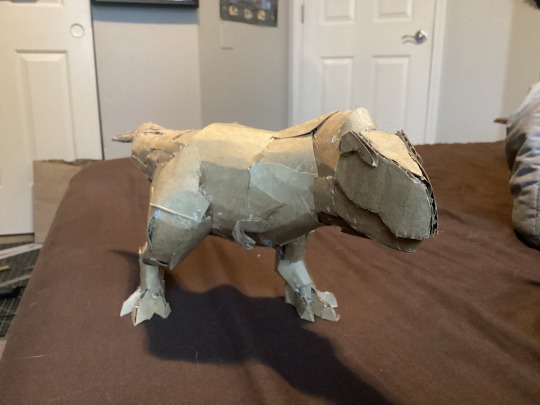

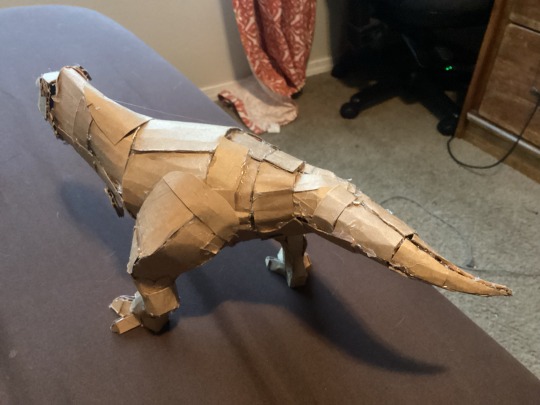
his current name (which is not yet set in stone) is Belisarius Vincent Chlorine Revolution (she/he/they pronouns)
this project has taken me 3 days, which is way less time than most of my even simpler cardboard sculptures, however i think my speedy construction is probably due to the fact that i've been snowed in for like half a week or so and have had little else to do. so i've mostly just been doing this
the og goal was to build up a cardboard base and then paper maché on top of it to then paint, but now that i'm done with the cardboard and it's the best cardboard sculpture i've ever done i am scared to ruin it or that the finished product won't live up to my expectations. so. uh. im gonna give it some time and maybe i'll do that at a later date but i might also just not. who knows 👍
oh and reblog are, as always, greatly appreciated. i would like attention for the thing i made pretty please
#tyrannosaurus rex#t rex#tyrannosaurus#tyrannosaur#dinosaurs#dinosaur art#theropod#cardboard sculpture#things i made#things i said
59 notes
·
View notes
Photo
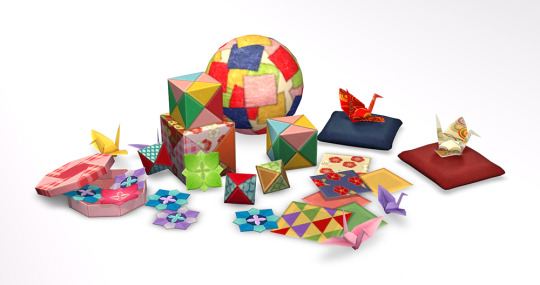
Origami Deco Converted to TS2 from Animal Crossing : Pocket Camp
Three of the objects are found under Decorative/Sculpture for 25$/45$: a paper crane (both recolours pictured) and two ‘assortments’ of various crafts and papers. Those have higher than average poly counts, which I’ve noted in their in-game descriptions just to be safe. The fourth object is a round papier maché lamp found under Lights/Table Lamps for 40$. No extra recolours included this time; tbh I didn’t feel like making any.
Also: I went back and tagged my other Animal Crossing conversions (both PC and NH) as “ac to ts2″. Could be cool to get that started as a tag since I’ve seen other conversions from those games.
-> download at SimFileShare
266 notes
·
View notes
Text
What if I start doing paper maché sculptures again
5 notes
·
View notes
Text






Couple weeks ago we had to make a paper maché model for some still life arrangements and being such a cool dude I made 808. However a part of the project was breaking our sculpture so I cut a chunk of her ear off and made a cigarette (it ended up looking more like a blunt 😭)

#hi fi rush#hi fi rush fanart#hfr#808#hfr fanart#hi fi rush 808#silly little guy#zaza#Pinks Artworks
35 notes
·
View notes
Text


A paper maché puppets of Lestat and Louis from Interview with the Vampire. They are for sale individually (but not by me).
2 notes
·
View notes
Text
Shinoda no Mori Kuzunoha Inari Shrine




I went to get my friend one of their paper maché fox sculptures, as well as an Ofuda and Omamori. This shrine enshrines quite a few Kami, but the one I thought was the most interesting was 若宮葛ノ葉姫 Wakamiya Kuzunoha Hime, the mother of Abe no Seimei a famous court Onmyōji. It was found out she was a kitsune, and she left her son behind. A very sad story, but an example of a kitsune story where the kitsune was benevolent.




Inari Shrines often have Buddhist elements, and this shrine was no exception, I found some Kannon statues and a statue of a Buddhist monk on the grounds.
And finally the shrine items and Goshuin


0 notes
Text
The Best Ideas!
Makeup Look about Androgyny
Photography portfolio of my experience in Philadelphia
Paper maché sculpture of a "Techno-fish"
Political Cartoons About Temple University
0 notes
Text
I think I know this artist!! His name is Kristian Brevik, and among other works of art, he creates these whale sculptures/lamps using paper maché and LEDs! :)
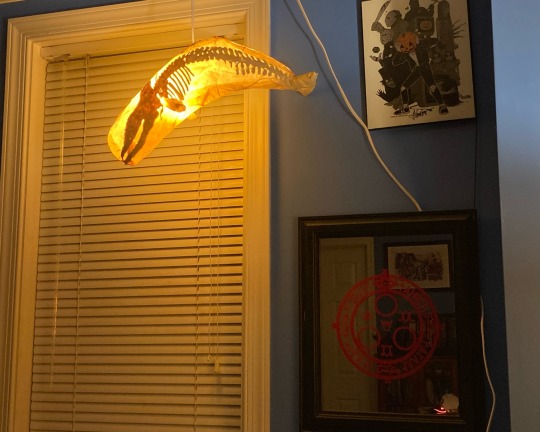


now that I have it hung please look at this unfuckingbelievably cool lamp my wife gave me for christmas
1K notes
·
View notes
Text
My Mini-Me
When we began our mini-mi we got to choose from a range of materials. I decided to go with cardboard as my main material, Sarah, the sculpture tutor helped me start my piece by recommending I crumple the cardboard up to make it more flexible and moldable, I shaped it as much as I could into a face and added brown gum tape which acted as a papier maché, this could mold my cardboard more and add structure to it.
Here are progress photos of my piece:




Before going any further, I decided to sketch out what I wanted my character to look like.

I wanted to mix my style with the style of the illustrator Paola Escobar (from my chosen children's book.) I found that Paola's character design style is very simple, yet she likes to add intricate detail to the clothes, I also found that she usually adds a soft blush and sketchy lines to her characters too which was something I tried to illustrate on my mini me.


To finish my mini me's face I added cut- out paper eyes and glasses which I made with wire. For the hair I stuck cardboard to the head and placed plasticine over it to make it look more hair-like.
Finally for the outfit, as I said earlier Paola likes to add nice detail to her clothes especially in this book, her clothing designs were also inspired by 1920's flapper style dresses as well as art deco lines and shapes, so I wanted to illustrate this by adding designs inspired by those styles. Below you can see I painted these designs using gold paint to add a pop of colour to the material, gold is also a main feature of art deco style.
More progress pictures of my mini-me!


At the end of the day we got to photograph our mini-me's in the photography room using the camera and lighting equipment.
Here's how mine turned out:

As you can see above the material adds more texture to the character much like Paola's signature design technique, I'm happy how it turned out.
Next time I could sew the material to make a cleaner and less messy outfit for the character and perhaps figure out a better way to stand the character because I did have a lot of trouble with that as my mini-me was very heavy due to the materials being very top heavy.
1 note
·
View note
Text
Kiki Smith

Untitled 1987-90
In Smith’s long-standing engagement with the body, she has often addressed issues of sexuality, feminism, and mortality. This work is composed of glass water-cooler bottles coated with silver and etched with the names of twelve bodily fluids: tears, urine, milk, blood, saliva, vomit, sperm, etc. Drawn from the theology of Smith’s Catholic faith, the fluids constitute the sacramental body. The German Gothic lettering on the bottles is a reference to a medieval book of hours, a Christian prayer book. According to the artist, “I was very influenced by the lives of the saints when I was a kid—you have a body with attributes and artifacts evoked by a sort of magic.”

Kiki Smith; Untitled; 1990; paper and wood; 20 x 18 x 18 inches; Museum of Fine Arts, Boston

Kiki Smith; Untitled; 1995; paper,methyl cellulose and horse hair; 53 x 18 x 50 inches

Kiki Smith; Rapture; 2001; bronze

Kiki Smith; Born; 2002; bronze; 39 x 101 x 24 inches

Kiki Smith; Tale; 1992; wax, pigment, paper maché; 160 x 23 x 23 inches

Kiki Smith; Pupet; 2000; nepal paper, muslin, glass, 54 inches high

Kiki Smith
Untitled 1990
Since the 1980s, much of Kiki Smith’s work has focused on the human body—probing it, distorting it, fragmenting it, and making visible what is usually imperceptible or private. “I use the body because it is our primary vehicle for experiencing our lives,” she has explained. “It’s something everyone shares.” Smith once spent three months training to be an emergency medical technician, studying medical texts and cadavers, and her hand-wrought sculptures convey an obsessive attention to anatomical detail. Untitled is one of Smith’s earliest forays into large-scale sculpture using wax, a medium that would occupy her for years. Two figures, one male and one female, hang limply from adjacent poles; milk drips from the woman’s breasts and semen runs down the man’s legs. Although these are life-giving secretions, both figures appear suspended in a state near death, their heads bowed languidly. Layers of red-tinted wax suggest the permeability and vulnerability of human flesh and internal organs.


Untitled (Butterfly). , 1994
Kiki Smith was born in Nuremburg, Germany in 1954.
Her interest in bodily parts manifested itself as early as 1979, and by 1985 she was certified as an Emergency Medical Technician. The experience of training to be an EMT reinforced her interest in the body: "It is physically very beautiful to look at the exposure of the insides and outsides at the same time."5 By the mid '80s, her underground reputation for creating strange, quirky drawings, prints, and sculptures that focused on bodily fluids, secretions, systems, and parts began to surface. Smith's first major New York gallery show at Fawbush Gallery in 1988 won her great acclaim and launched her national and international reputation.
Smith's approach to her subject matter is poetic, emotive, and frequently melancholy. Her large crystal sperms (made of glass) are objects of beauty; her paper sculptures, mostly figures of women, hang delicately and often mournfully from ceilings.6 Her images--of the womb, the digestive tract, the nervous system, hair (for example the lithograph, Untitled, 1990, AMAM inv. 91.27)--project humor as well as pathos. Around 1990, Smith began to create lifesize figures in bronze or colored wax. Mostly female, these figures are haunting in their sense of loss: leaking milk or sperm, trailing blood or feces, bent on their knees, with an external spine or slashed skin that exposes red-tinted flesh beneath.
Smith's choice of materials is distinctive and integral to the object's effect on the viewer. She works on paper and with cast glass, bronze, plaster, terra cotta, papier mâché, cloth, and other media, and frequently adds embroidery, weaving, and inks to her works. Prints, which she began making in 1989, as well as installations, are also central to her creative production.

untitled, 1996
CC I know that you have also done death masks. Do you feel different casting live people than when you do the death masks?
KS I like dead people better. Casting is problematic, it’s like playing freeze tag, you cast people in all these different positions and they’re frozen. The wax museums didn’t make casts of people, they made sculptures of them. Casting, like photography, is a single moment. Whereas if you sculpt people’s faces, it’s a more generalized version of the person, but in a certain sense more accurate than one specific second of them. When you cast people, it makes a kind of stiffness, and unless you really fuck around with the cast, there’s something dead about it, especially when you go from the cast into metal. Bronze is dead material, so you have to have some kind of texture to make it live. Whereas the translucency of the wax is like skin so it makes them live, you don’t have to have any surface stuff. In any case, dead people are just dead, you don’t have to make them look alive. (laughter)

Virgin Mary, 1993



Kiki Smith (born January 18, 1954) is a West German-born American artist whose work has addressed the themes of sex, birth and regeneration. Her figurative work of the late 1980s and early 1990s confronted subjects such as AIDS and gender, while recent works have depicted the human condition in relationship to nature. Smith lives and works in the Lower East Side neighborhood of New York City.
Prompted by her father's death in 1980 and by the AIDS death of her sister, the underground actress, Beatrice “Bebe” Smith in 1988, Smith began an ambitious investigation of mortality and the physicality of the human body. She has gone on to create works that explore a wide range of human organs; including sculptures of hearts, lungs, stomach, liver and spleen. Related to this was her work exploring bodily fluids, which also had social significance as responses to the AIDS crisis (blood) and women's rights (urine, menstrual blood, feces).


Kiki Smith, Untitled (Roses), 1993-94
Born in Germany, American sculptor and print maker Kiki Smith (born 1954) attended Hartford Art School, Connecticut. Influenced by a generation of female artists including Louise Bourgeois, Eva Hesse and Lee Bontecou, Smith uses paper, fabric, ceramics and glass to create figurative sculptural works which mediate the separations between the psychological and physical nature of the body. Smith has exhibited in America and Europe since the 1980s.

Peacock 1994
Combining sculpture and print, ‘Peacock’ is a papier mâché sculpture of a crouched female, hugging her knees in a self-protective pose. The woman’s head is slightly cocked as she ponders the prints of female genitalia, which are fanned out on the wall like a peacock’s tail. The prints are physically linked to her body by 28 umbilical-like threads of paper, making direct reference to the female reproductive cycle. In Smith’s print work, the visceral is often counterbalanced by an impulse toward the refined and the decorative, seen here in the use of fine handmade paper and in the delicate lines of the drawn jewelry which adorns the figure.
0 notes
Text
Painting : Portrait Project Interpretive Portrait
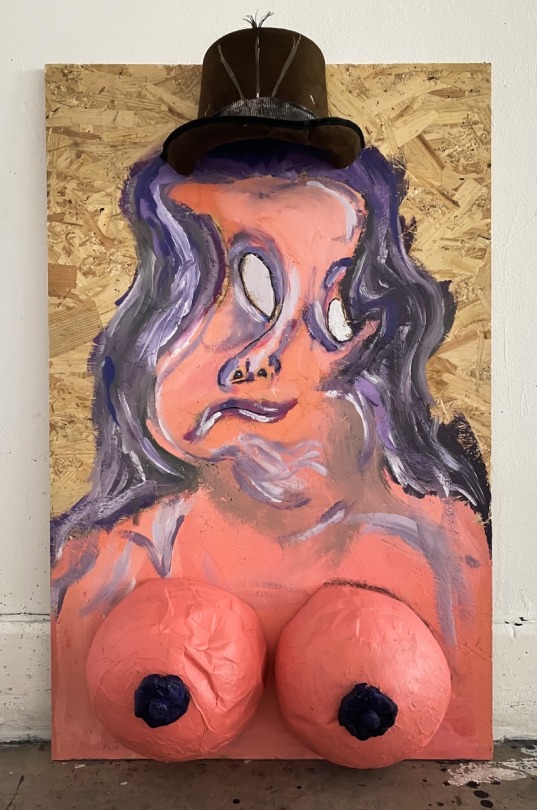
Here I created an interpretative portrait based on images I took of my brother which I later warped. Going into this piece I wanted to combine elements of both painting and sculpture.

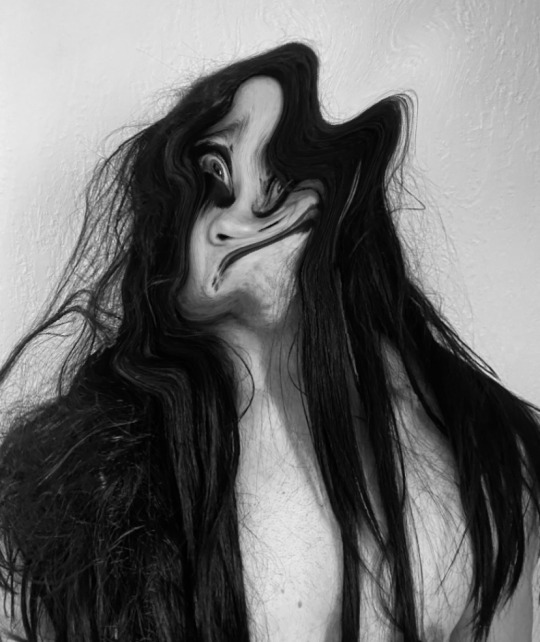
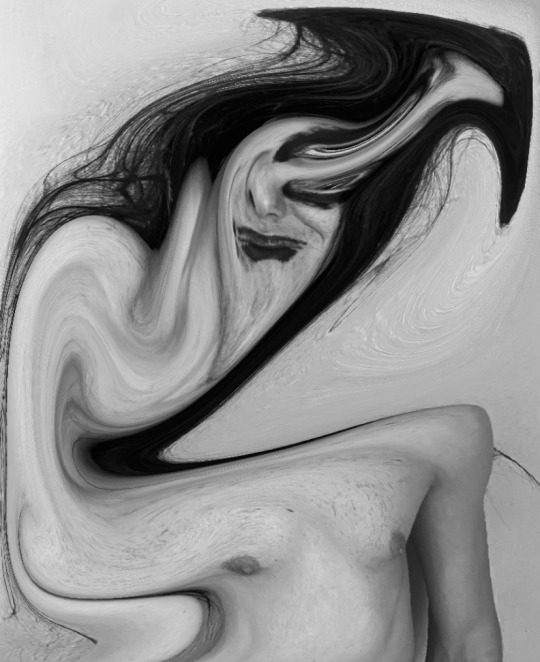
I chose to create this piece using a wooden board as I wanted to make work that departs from the use of paper. The texture and look of the wooden board is quite attractive to me as it blends very well with the paint.
I didn’t want to spend an excessive amount of time painting the main subject. This was because I wanted to give a fluid and warped look to the piece instead of focusing on specific tonal details.
I chose to create the piece using only purple and pink tones as I wanted to make the piece vibrant but not too cluttered and take the attention away from what I wanted to convey.
I used a hat from home which I then cut in half to attach the the board.
I wanted to give the portrait an exaggerated look so I created two large breast pieces using a paper maché technique. This was done by attaching strips of newspaper to blown up balloons using wallpaper glue.
Overall I was quite satisfied with the finished piece as I successfully created the idea I had in mind.
Below was inspiration for the hat concept. This includes characters from film and television that wear a trademark hat.
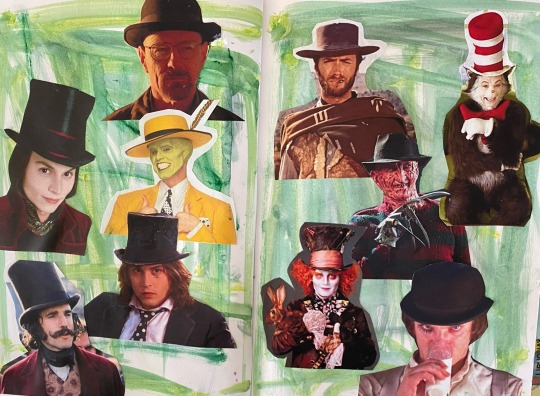
1 note
·
View note
Photo

Les Farfelus Farfadets, Unique ‘Swirl’ Mirror, 2017,
Papier-mâché, Mirrored glass,
90 cm. (351⁄2 in.) Diameter.
Courtesy: Christie’s
#art#design#mirror#frame#mirror frame#paper#papier-maché#les farfelus farfadets#christie's#sculpture#forms#abstract art#abstraction#white
6 notes
·
View notes
Text
🤍 My Easy DIY Paper Mache Recipe! | Thin Toilet Paper, White Paint, Elmer’s Glue, & Water 🤍
https://youtube.com/shorts/2EfjIYG-Edo?feature=share
#papermache#paper mache#artist#art#sketchbook#sculpture#visionary#crafts#diy#arts and crafts#arts & crafts#artwork#sketchbooktour#painting#mixing#homemade#original art#black art#paper mache art#paper maché#paper machè#white#paint#painter#working artist#kids#easy
2 notes
·
View notes
Link
Steampunk bat boy!!
1 note
·
View note
Photo




Cecilia Levy creates sculptural objects in paper, using old book pages, wheat starch paste and papier maché technique.
She lives in Sigtuna, works in her studio at Ateljéföreningen Hospitalet in Uppsala and is a member of Konsthantverkarna in Stockholm, where her work is sold.
Formerly a graphic designer and bookbinder, I now work fulltime as an independant artist. My work includes sculptures, objects and installations, using paper from old books.
https://www.homofaber.com/en/event#
https://www.cecilialevy.com/
19 notes
·
View notes